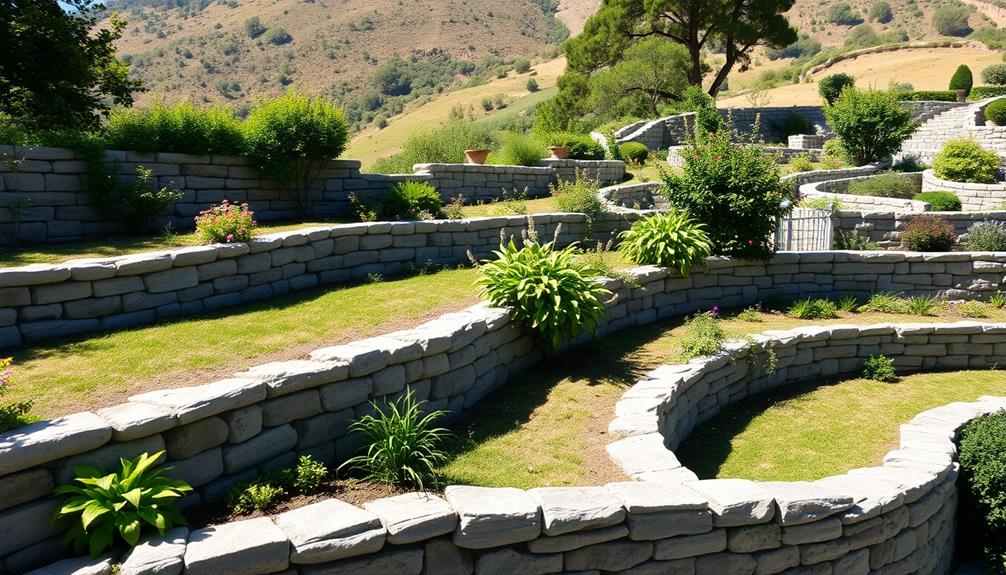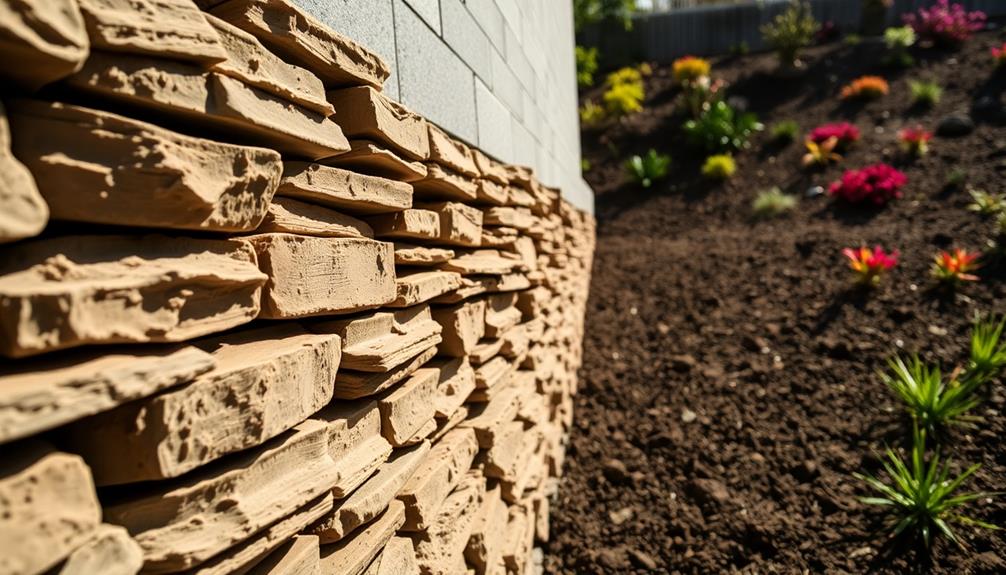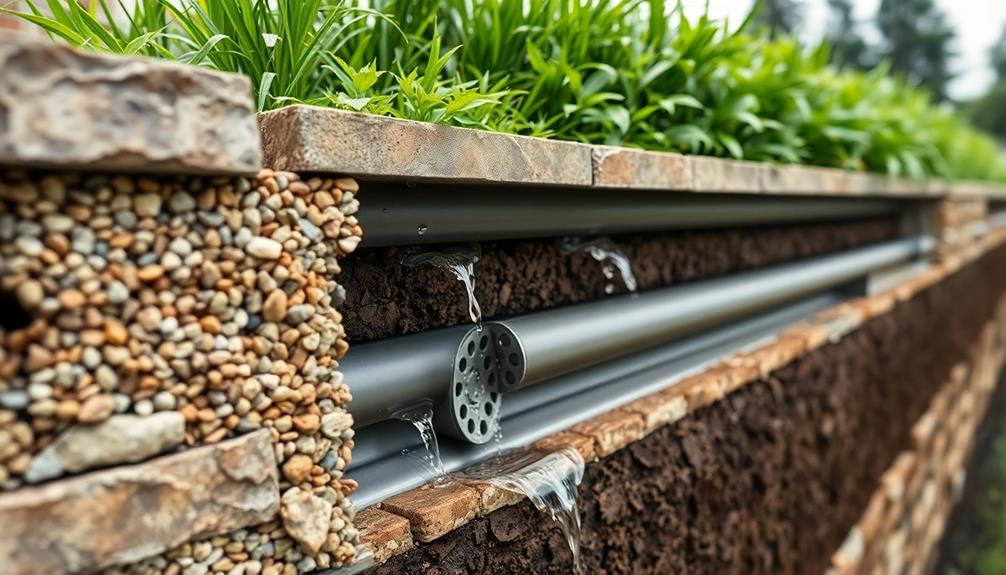Selecting the appropriate retaining wall materials involves evaluating several key factors. Durability, aesthetic appeal, cost, maintenance requirements, and environmental impact are indispensable considerations. Common options include natural stone, concrete blocks, treated timber, segmental concrete units, and gabion baskets, each offering unique benefits and drawbacks. Professional installation is essential to guarantee proper footing, drainage, and compliance with local building codes. The chosen material should withstand soil conditions, facilitate effective drainage, and integrate seamlessly with the surrounding landscape. Additionally, factors such as erosion prevention capabilities and the potential to increase usable space should be weighed. Further exploration of these elements will provide an exhaustive understanding of retaining wall material selection.
Table of Contents
ToggleWalls Contractor Highlights
- Assess material durability and longevity to ensure the wall withstands weathering and maintains structural integrity over time.
- Consider aesthetic appeal, choosing materials that complement the surrounding landscape and architecture.
- Evaluate cost and maintenance requirements, balancing initial investment with long-term upkeep expenses.
- Select materials compatible with site-specific drainage needs and soil conditions to prevent water-related issues.
- Prioritize eco-friendly options with low carbon footprints when possible to minimize environmental impact.
Purpose of Retaining Walls

Retaining walls serve multiple vital functions in landscape architecture and property management. These structures effectively combat soil erosion by stabilizing slopes and preventing the downward movement of earth, while simultaneously offering opportunities for creative landscape design enhancement through the introduction of multi-level gardens, terraces, or decorative elements.
Boulder walls are particularly versatile, providing a natural, rustic aesthetic that can be custom-designed to fit various project requirements. Additionally, well-constructed retaining walls can considerably increase property value by maximizing usable land area, improving drainage, and creating visually appealing outdoor spaces that blend functionality with aesthetic appeal.
Soil Erosion Prevention
One of the primary purposes of retaining walls is to hold back soil and prevent erosion. These structures play a pivotal role in maintaining landscape stability, particularly in areas with sloping terrain or where water runoff poses a significant threat. By effectively managing soil movement, retaining walls contribute to the overall health and longevity of your property’s landscape.
When considering soil erosion prevention, it is of utmost importance to understand the key factors that influence a retaining wall’s effectiveness:
- Material choice: Select materials that can withstand the pressure exerted by soil and water, such as concrete blocks, natural stone, or treated timber.
- Proper drainage: Incorporate adequate drainage systems to redirect water away from the wall, reducing hydrostatic pressure and minimizing erosion.
- Professional installation: Guarantee the wall is constructed with proper footing, backfill, and compaction techniques to maximize its structural integrity and erosion-prevention capabilities.
Landscape Design Enhancement
Beyond their practical functions, retaining walls serve as powerful design elements in landscape architecture. These structures can transform an ordinary outdoor space into a visually striking and harmonious environment, enhancing the overall aesthetic appeal of a property. By strategically incorporating retaining walls into the landscape design, homeowners and designers can create multi-level gardens, define separate outdoor rooms, and add depth and dimension to otherwise flat terrain.
The choice of materials for retaining walls plays a vital role in achieving the desired visual impact. Natural stone walls, with their rugged textures and earthy hues, can evoke a sense of timeless elegance and seamlessly blend with natural surroundings. Alternatively, concrete blocks offer a more contemporary look, with clean lines and uniform shapes that can complement modern architectural styles. For those seeking a rustic charm, timber retaining walls provide warmth and character, while also allowing for easy integration of built-in seating or planter boxes. By carefully selecting materials that harmonize with the existing landscape and architectural elements, retaining walls can become focal points that elevate the entire outdoor living experience, creating a cohesive and inviting atmosphere for residents and visitors alike.
Property Value Increase
While the aesthetic and functional benefits of retaining walls are significant, their impact on property value is equally remarkable. A well-constructed retaining wall can substantially increase a home’s market value by enhancing curb appeal, maximizing usable land, and preventing soil erosion. Prospective buyers often view retaining walls as valuable additions that demonstrate thoughtful landscaping and property maintenance.
When considering the potential for property value increase, homeowners should focus on:
- Material quality: Opt for durable, high-grade materials that withstand weathering and require minimal maintenance.
- Professional installation: Guarantee proper construction techniques are employed to guarantee longevity and structural integrity.
- Design cohesion: Select materials and styles that complement the existing architecture and landscape.
Benefits

Retaining walls offer a multitude of benefits that extend beyond their primary structural function. These versatile landscaping elements can dramatically improve the aesthetic appeal of a property, enhance its overall value, and provide critical protection against soil erosion in areas prone to instability.
Boulder retaining walls are particularly effective in this regard, offering a natural and long-lasting solution that combines functionality with visual appeal. They can also serve as a decorative extension of the home, adding character and charm to the landscape.
Additionally, by effectively managing sloped terrain, retaining walls create additional usable space on a property, allowing homeowners to maximize their outdoor living areas and potentially expand their landscaping options.
Improved Landscape Aesthetics
Landscape transformation is a key benefit of well-chosen retaining wall materials. These structural elements not only serve a functional purpose but also contribute profoundly to the visual appeal of your outdoor space. By selecting materials that complement your existing architecture and natural surroundings, you can create a cohesive and aesthetically pleasing environment that enhances your property’s overall value and charm.
When considering the aesthetic impact of retaining wall materials, focus on:
- Texture: Incorporate materials with varied textures to add depth and visual interest to your landscape design.
- Color: Choose hues that harmonize with your home’s exterior and surrounding vegetation for a balanced look.
- Pattern: Explore different patterns or arrangements to create unique focal points within your outdoor space.
Well-designed retaining walls can transform mundane slopes into visually striking terraced gardens, creating opportunities for diverse plantings and outdoor living areas. They can frame and accentuate key landscape features, such as water elements or seating areas, while providing a sense of structure and organization to your outdoor environment. By carefully selecting materials that align with your aesthetic vision, you can create a landscape that not only meets your functional needs but also reflects your personal style and enhances your connection to your outdoor space.
Enhanced Property Value
Beyond their functional and aesthetic advantages, well-designed retaining walls can markedly boost a property’s market value. These structural enhancements not only improve the usability of outdoor spaces but also contribute significantly to curb appeal, a pivotal factor in real estate appraisals.
By maximizing usable land area, particularly in sloped or challenging terrains, retaining walls effectively increase the property’s functional square footage, translating to higher valuations.
Prospective buyers often perceive well-constructed retaining walls as valuable investments, recognizing their role in erosion control, soil stabilization, and overall landscape enhancement. The choice of materials plays a vital role in this value proposition.
High-quality, durable materials such as natural stone or engineered concrete blocks not only ensure longevity but also convey a sense of permanence and quality craftsmanship. These attributes resonate with potential buyers seeking low-maintenance, long-lasting property features.
Additionally, retaining walls that incorporate complementary design elements, such as built-in seating or integrated lighting, further elevate the property’s perceived value. By strategically implementing retaining walls with carefully selected materials, homeowners can create a distinct competitive advantage in the real estate market, potentially yielding substantial returns on their investment.
Soil Erosion Prevention
One of the primary functions of a well-constructed retaining wall is its ability to prevent soil erosion effectively. By strategically placing these structures, we can mitigate the impact of environmental factors that contribute to soil displacement. Retaining walls serve as a robust barrier against the forces of nature, protecting our landscapes and ensuring the stability of our outdoor spaces.
When selecting materials for your retaining wall, consider their erosion-prevention capabilities. The most effective options include:
- Concrete blocks: Durable and versatile, offering excellent resistance to weathering and erosion
- Natural stone: Aesthetically pleasing and highly effective at redirecting water flow
- Treated timber: Cost-effective and suitable for areas with moderate erosion concerns
These materials, when properly installed, create a formidable defense against soil erosion. They work by intercepting surface runoff, reducing water velocity, and promoting proper drainage. This not only preserves the integrity of your landscape but also safeguards nearby structures from potential damage.
Increased Usable Space
A significant benefit of installing retaining walls is the substantial increase in usable space they provide. By strategically implementing these structures, homeowners can transform sloped or uneven terrain into functional areas for various purposes. This expansion of usable land not only boosts property value but also creates opportunities for landscaping, outdoor living spaces, and additional storage solutions.
Retaining walls effectively manage elevation changes, allowing for the creation of level surfaces on previously challenging landscapes. These newly formed flat areas can be utilized for gardens, patios, or recreational spaces, greatly expanding the potential of your property. Additionally, the installation of retaining walls can facilitate the construction of terraced gardens, which not only maximize land use but also add visual interest to your outdoor environment.
In urban settings, where space is often at a premium, retaining walls can be particularly valuable in reclaiming previously unusable areas, transforming them into practical extensions of your living space. By carefully selecting appropriate materials and design elements, homeowners can ensure that their retaining walls seamlessly integrate with existing architecture and landscaping, further enhancing the overall aesthetic appeal of their property.
Drainage Considerations for Walls

Effective drainage is critical for the longevity and stability of retaining walls, necessitating careful consideration of water management techniques during construction. The selection of appropriate backfill materials plays a pivotal role in facilitating proper drainage and preventing hydrostatic pressure buildup behind the wall. Strategic placement of weep holes further enhances the wall’s ability to channel water away, reducing the risk of structural damage and soil erosion over time.
| Drainage Consideration | Importance | Key Features |
|---|---|---|
| Proper Water Management | High | Prevents soil saturation and wall instability |
| Backfill Material | Crucial | Allows water flow and reduces pressure |
| Weep Hole Placement | Essential | Facilitates water exit and pressure relief |
| Grading and Slope | Important | Directs water away from wall foundation |
Proper Water Management Techniques
Proper water management stands as a critical factor in the longevity and stability of retaining walls. Effective drainage systems prevent hydrostatic pressure buildup behind the wall, which can lead to structural failure and costly repairs.
To guarantee optimal water management, consider implementing the following techniques:
- Install a perforated drainage pipe at the base of the wall, surrounded by gravel, to collect and divert water away from the structure.
- Incorporate a layer of permeable backfill material, such as crushed stone or gravel, behind the wall to facilitate water movement.
- Design and construct proper surface grading to direct runoff away from the top of the wall and prevent water from accumulating near the structure.
Backfill Material Selection
Selecting the right backfill material is paramount for ensuring proper drainage and structural integrity of retaining walls. The choice of backfill directly impacts the wall’s ability to manage water pressure and resist soil movement, factors critical to its longevity and performance. When considering backfill options, it is vital to prioritize materials that facilitate efficient drainage while providing adequate support.
Granular materials, such as crushed stone or gravel, are often preferred for their superior drainage properties. These materials allow water to flow freely through the spaces between particles, reducing hydrostatic pressure behind the wall. Clean, angular gravel ranging from 3/4 to 1 1/2 inches in size is particularly effective.
For added stability, a mixture of sand and gravel can be utilized, striking a balance between drainage and compaction. It is imperative to avoid using clay-rich soils or organic materials as backfill, as these retain moisture and can lead to excessive pressure on the wall. Additionally, incorporating a layer of geotextile fabric between the native soil and backfill material can prevent soil migration and further enhance drainage capabilities, ensuring the long-term stability and effectiveness of your retaining wall system.
Weep Hole Placement
Weep holes play an essential role in managing water drainage for retaining walls, safeguarding their structural integrity and longevity. These small openings, strategically placed along the base of the wall, allow accumulated water behind the structure to escape, thus preventing hydrostatic pressure buildup. Proper weep hole placement is pivotal for maintaining the wall’s stability and preventing potential damage caused by water retention.
When considering weep hole placement, keep in mind the following key factors:
- Spacing: Generally, weep holes should be placed at intervals of 4 to 6 feet along the length of the wall, ensuring adequate drainage coverage.
- Size: Typically, weep holes should be 3/8 to 1/2 inch in diameter, large enough to allow water flow but small enough to prevent excessive soil loss.
- Positioning: Install weep holes slightly above grade level to facilitate proper drainage and prevent clogging from surrounding soil.
Walls Contractor FAQ
How Tall Can a Retaining Wall Be Without Requiring Engineering Approval?
For our community projects, retaining walls up to 4 feet tall generally don’t require engineering approval. However, local regulations may vary, so it’s best to check with your area’s building department before starting construction. Safety always comes first!
What Is the Average Lifespan of Different Retaining Wall Materials?
The average lifespan of retaining wall materials varies extensively. Concrete blocks can last 50-100 years, while treated timber may last 20-40 years. Natural stone walls can endure for centuries when properly constructed and maintained. Regular upkeep is indispensable for longevity.
Can Retaining Walls Be Built on a Slope or Uneven Ground?
Yes, retaining walls can be constructed on slopes or uneven ground. Our team of experts utilizes specialized techniques and materials to guarantee stability and safety. We work together to overcome site challenges and create a seamless, durable solution for your property.
Are There Eco-Friendly Options for Retaining Wall Materials?
Yes, eco-friendly retaining wall materials are available for environmentally conscious homeowners. Options include reclaimed wood, recycled plastic lumber, locally sourced natural stone, and gabion walls filled with recycled concrete or repurposed materials. These choices promote sustainability in landscaping projects.
How Much Maintenance Do Different Types of Retaining Walls Require?
Maintenance requirements vary among retaining wall types. Natural stone and concrete blocks typically need minimal upkeep, while wooden walls require regular sealing and inspection. Gabion walls are low-maintenance, but vegetation-based walls need consistent care to guarantee plant health and stability.







